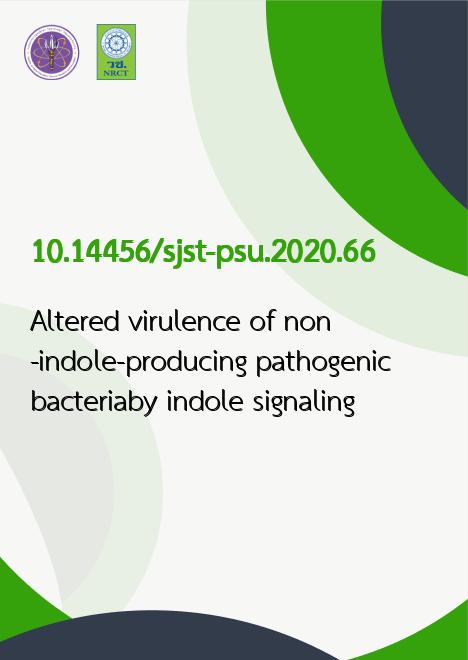
|
Altered virulence of non-indole-producing pathogenic bacteriaby indole signaling |
|---|---|
| รหัสดีโอไอ | |
| Creator | 1. Paramaporn Rattanaphan 2. Thunchanok Yaikhan 3. Pawina Rachniyom 4. Pimonsri Mittraparp-Arthorn 5. Varaporn Vuddhakul 6. Natta Tansila |
| Title | Altered virulence of non-indole-producing pathogenic bacteriaby indole signaling |
| Publisher | Research and Development Office, Prince of Songkla University |
| Publication Year | 2563 |
| Journal Title | Songklanakarin Journal of Science and Technology |
| Journal Vol. | 42 |
| Journal No. | 3 |
| Page no. | 515-520 |
| Keyword | indole, biofilm formation, virulence, non-indole-producing bacteria, signaling molecule |
| URL Website | https://rdo.psu.ac.th/sjstweb/index.php |
| ISSN | 0125-3395 |
| Abstract | Bacteria naturally live in a multispecies community. Cell-to-cell communication is therefore crucial for bacteria toadapt, survive, and regulate virulence. Indole has been recently reported as an intercellular signal that regulates diverse bacterialphysiologies such as biofilm formation, antibiotic tolerance, and virulence factor production. The role of indole on bacterialvirulence was mainly studied in indole-producing bacteria. Therefore, this study aimed to study the effect of indole on pathogenicnon-indole-producing bacteria including Klebsiella pneumoniae, Proteus mirabilis, and Enterobacter cloacae. Bacteria werecultured in a physiological concentration of indole (1 mM), and then growth, biofilm formation, autoaggregation, and motilitywere evaluated. Indole could increase biofilm formation and autoaggregation of K. pneumoniae, whereas biofilm formation andautoaggregation decreased in E. cloacae and P. mirabilis. Growth of K. pneumoniae and E. cloacae was slightly affected byexposure to indole. This finding indicated that indole influences the virulence of pathogenic non-indole-producing bacteria indifferent ways. Further studies are still required for a better understanding of the biological functions of indole signaling. |
